
How Hotpatching on Windows Server is changing the game for Xbox
Learn how Microsoft has been using Hotpatch with Windows Server 2022 Azure Edition to substantially reduce downtime for SQL Server databases.



This post was authored by Rob Hindman, Senior Program Manager, Windows Server.
We asked what you needed in the next release of Windows Server and we heard you clearly: you have made significant investments in the IT infrastructure that is used to deliver results for your business. When you upgrade the Hyper-V and Scale-out File Server clusters in your private cloud or datacenter to a new version of Windows Server, you don’t want users to notice. You don’t want your SLAs to be impacted in the slightest bit, and you don’t want to buy new hardware. You want to use new features in Windows Server 2016 as soon as possible.
The Cluster OS Rolling Upgrade feature in Windows Server 2016 is our response to your requests. Cluster OS Rolling Upgrade introduces a new concept called Mixed-OS mode, which allows customers to start with a Windows Server 2012 R2 failover cluster, and add Windows Server 2016 server nodes to the cluster. Using a sequential process of draining, evicting, upgrading, then adding and resuming each node, any failover cluster can be upgraded. Details include:
Upgrade any Windows Server 2012 R2 cluster, physical (host) or virtual (guest) cluster.
After all nodes in the cluster have been upgraded to Windows Server 2016, the administrator uses the Update-ClusterFunctionalLevel cmdlet to commit the cluster to permanently running Windows Server 2016 nodes only – at which point the new Windows Server 2016 features become available.
Only Hyper-V and the Scale-out File Server (SoFS) clusters can be upgraded without any downtime. The Hyper-V cluster makes use of VM Live Migration so the VMs will keep running while they are moved from Windows Server 2012 R2 to Windows Server 2016. The Scale-out File Server (SoFS) makes use of Continuously Available (CA) file handles which can move between cluster nodes without any data loss. For other workloads like SQL Server AlwaysOn Availability Groups and SQL Server AlwaysOn Failover Cluster Instance, downtime is equivalent to failover time.
As an example, let’s start with two Windows Server 2012 R2 clusters. The first cluster is a Hyper-V cluster of four VMs hosting eight VMs. The second cluster is a Scale-out File Server (SoFS) storage cluster for the VHDX files used by the Hyper-V cluster. Many customers like this converged (aka, disaggregated) strategy so that they can add nodes to either the Hyper-V or SoFS clusters, adding capacity to either cluster as needed. Assuming that there is capacity on each cluster to drain one node, the VMs can remain running.
Let’s see how we upgrade both of these clusters at the same time using Cluster OS Rolling Upgrade:
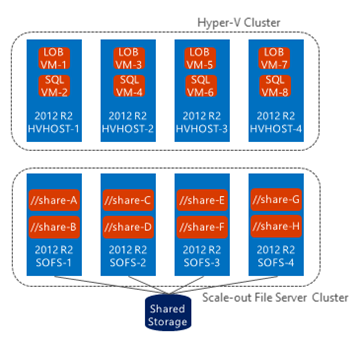
The VMs are Live Migrated off of HVHOST-1, and the SMB3 CA File shares are moved off of SOFS-1. Both of these nodes are evicted from their clusters:
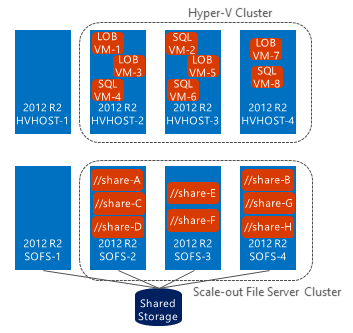
HVHost-1 and SOFS-1 are reformatted, and have Windows Server 2016 installed on them. They are both added back into their clusters, and VMs are Live Migrated onto HVHOST-1, and SMB3 CA File shares are moved to SOFS-1. HVHOST-2 and SOFS-2 are evicted from their clusters:
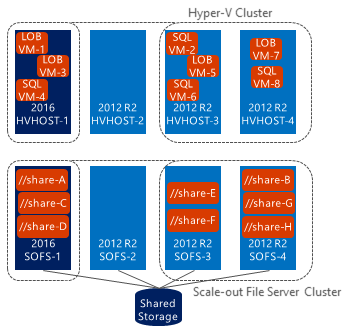
HVHost-2 and SOFS-2 are reformatted, and have Windows Server 2016 installed on them. They are both added back into their clusters, and VMs are Live Migrated onto HVHOST-2, and SMB3 CA File shares are moved to SOFS-2. HVHOST-3 and SOFS-3 are evicted from their clusters:
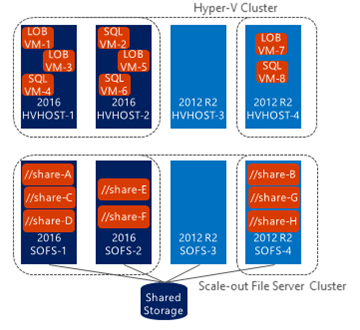
HVHost-3 and SOFS-3 are reformatted, and have Windows Server 2016 installed on them. They are both added back into their clusters, and VMs are Live Migrated onto HVHOST-3, and SMB3 CA File shares are moved to SOFS-3. HVHOST-4 and SOFS-4 are evicted from their clusters:
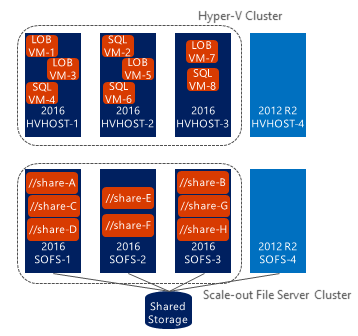
HVHost-4 and SOFS-4 are reformatted, and have Windows Server 2016 installed on them. They are both added back into their clusters, and VMs are Live Migrated onto HVHOST-4, and SMB3 CA File shares are moved to SOFS-4:
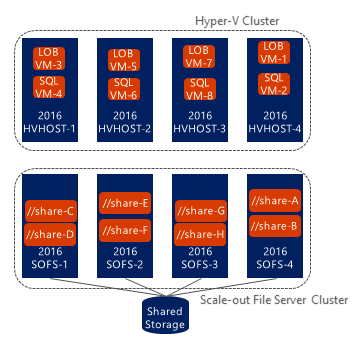
At this stage, the cluster is ready to be committed to Windows Server 2016 – the administrator is ready to run the Update-ClusterFunctionalLevel cmdlet. When this happens, new failover clustering features such as VM Compute Resiliency, VM Storage Resiliency, and the Cloud Witness can be used on the cluster. The upgrade process has completed without any downtime for the users of the VMs.
Cluster OS Rolling Upgrade can be used to upgrade any failover cluster from Windows Server 2012 R2 to Windows 2016. Used with Hyper-V VM Live Migration, there is no downtime for Hyper-V host clusters. Scale-out File Server (SoFS) clusters can also be upgraded without any downtime because of the Continuously Available (CA) file shares used by SMB3. Other cluster workloads like SQL Server AlwaysOn Failover Cluster Instance (FCI) and SQL Server AlwaysOn Availability Groups (AGs) can be upgraded with minimal downtime which is equivalent to failover time. Virtual (guest) clusters using Shared VHDX (Shared VHDX guest clusters) need to be logically detached from shared storage before upgrade, and reattached after the upgrade process has completed.
We’ve worked closely with many customers using Windows Server 2016 Technical Preview to ensure that Cluster OS Rolling Upgrade delivers the deployment agility that they need, reducing the time and cost needed to upgrade to Windows Server 2016.
To try this new feature in Windows Server 2016, download the Technical Preview. For additional details, see Cluster OS Rolling Upgrade on TechNet.
Notifications